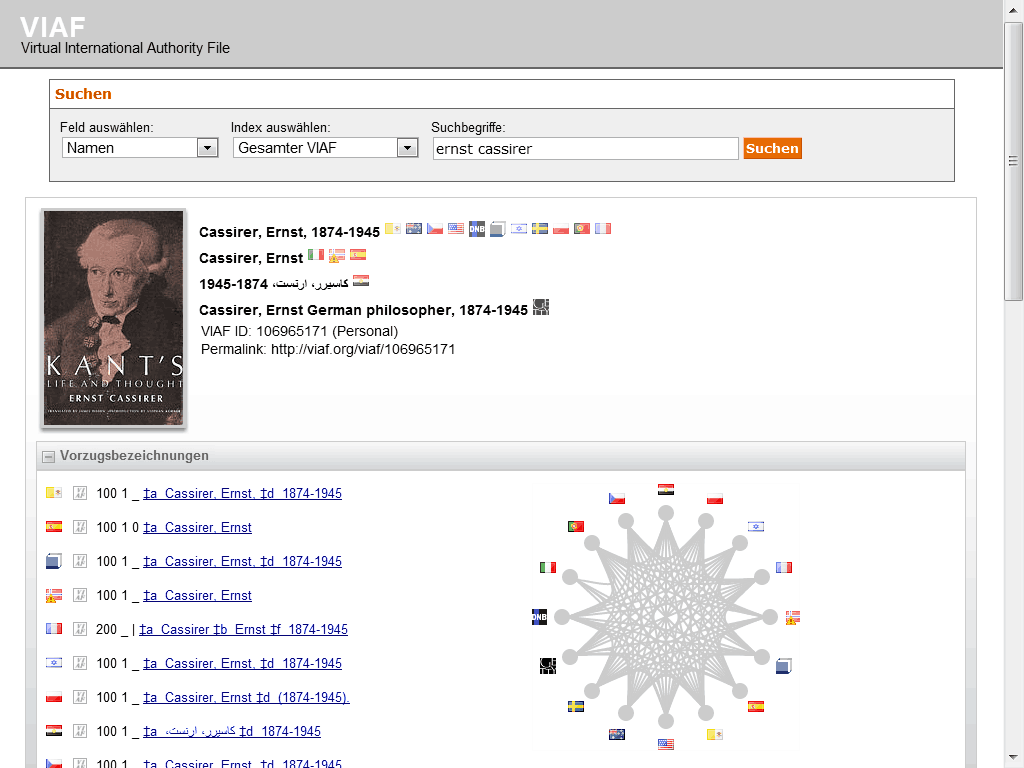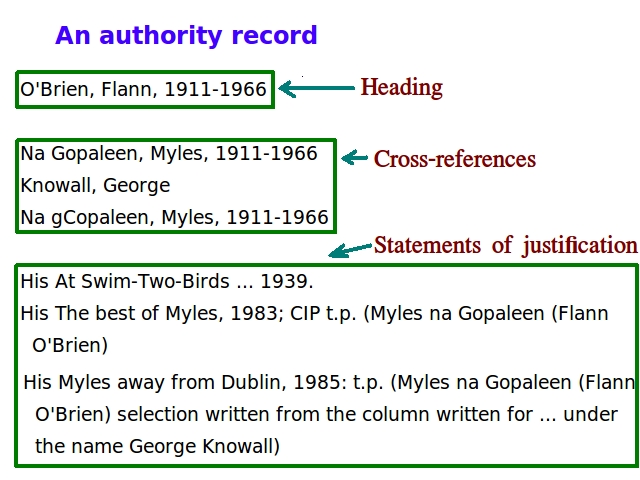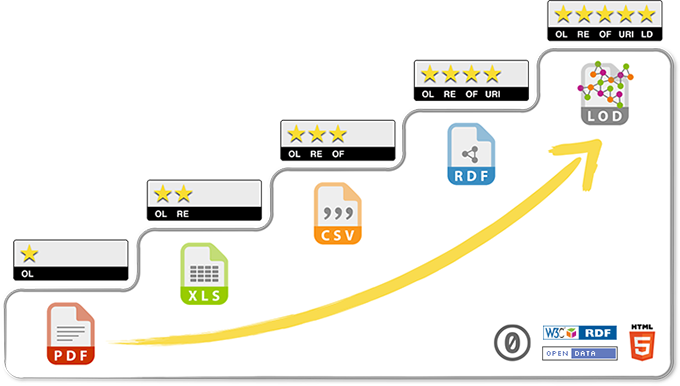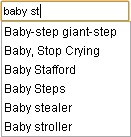|
Faceted Application Of Subject Terminology
Faceted Application of Subject Terminology (FAST) is a general use controlled vocabulary based on the Library of Congress Subject Headings (LCSH). FAST is developed as a part of WorldCat by OCLC, Inc., with the goal of making subject cataloging less costly and easier to implement in online contexts. FAST headings separate topical data from non-topical data, such as information about a document's form, chronological coverage, or geographical coverage. Unlike LCSH headings, which are pre-coordinated (multiple terms are linked together by the cataloger in a specific order, e.g. "United States -- History"), FAST headings are post-coordinated (terms are singly assigned, so the user can mix and match, e.g. "United States" and "History"). Use OCLC has been developing FAST since 1998, and originally intended the system to describe Web resources in simple metadata schemata, particularly Dublin Core. FAST separates headings into eight distinct facets: topical, geographic, personal name, cor ... [...More Info...] [...Related Items...] OR: [Wikipedia] [Google] [Baidu] |
Controlled Vocabulary
A controlled vocabulary provides a way to organize knowledge for subsequent retrieval. Controlled vocabularies are used in subject indexing schemes, subject headings, thesauri, taxonomies and other knowledge organization systems. Controlled vocabulary schemes mandate the use of predefined, preferred terms that have been preselected by the designers of the schemes, in contrast to natural language vocabularies, which have no such restriction. In library and information science In library and information science, controlled vocabulary is a carefully selected list of words and phrases, which are used to tag units of information (document or work) so that they may be more easily retrieved by a search. Controlled vocabularies solve the problems of homographs, synonyms and polysemes by a bijection between concepts and preferred terms. In short, controlled vocabularies reduce unwanted ambiguity inherent in normal human languages where the same concept can be given different name ... [...More Info...] [...Related Items...] OR: [Wikipedia] [Google] [Baidu] |
British Library
The British Library is the national library of the United Kingdom. Based in London, it is one of the largest libraries in the world, with an estimated collection of between 170 and 200 million items from multiple countries. As a legal deposit library, it receives copies of all books produced in the United Kingdom and Ireland, as well as a significant proportion of overseas titles distributed in the United Kingdom. The library operates as a non-departmental public body sponsored by the Department for Culture, Media and Sport. The British Library is a major research library, with items in many languages and in many formats, both print and digital: books, manuscripts, journals, newspapers, magazines, sound and music recordings, videos, play-scripts, patents, databases, maps, stamps, prints, drawings. The Library's collections include around 14 million books, along with substantial holdings of manuscripts and items dating as far back as 2000 BC. The library maintains a programme for ... [...More Info...] [...Related Items...] OR: [Wikipedia] [Google] [Baidu] |
Virtual International Authority File
The Virtual International Authority File (VIAF) is an international authority file. It is a joint project of several national libraries, operated by the Online Computer Library Center (OCLC). History Discussions about having a joint international authority started in the late 1990s. After several failed attempts to develop a unique joint authority file, the new idea was to link existing national authorities. This would present all the benefits of a standard file without requiring a significant investment of time and expense in the process. The project was initiated by the American Library of Congress (LOC), the German National Library (DNB), and the OCLC in April 1998 as a proof-of-concept that authority records can be linked. After extensive testing, the VIAF consortium was formed at the 2003 World Library and Information Congress, hosted by the International Federation of Library Associations. on 6 August 2003, and by September it had its own page at the OCLC website. ... [...More Info...] [...Related Items...] OR: [Wikipedia] [Google] [Baidu] |
Linked Data
In computing, linked data is structured data which is interlinked with other data so it becomes more useful through semantic queries. It builds upon standard Web technologies such as HTTP, RDF and URIs, but rather than using them to serve web pages only for human readers, it extends them to share information in a way that can be read automatically by computers. Part of the vision of linked data is for the Internet to become a global database. Tim Berners-Lee, director of the World Wide Web Consortium (W3C), coined the term in a 2006 design note about the Semantic Web project. Linked data may also be open data, in which case it is usually described as Linked Open Data. Principles In his 2006 "Linked Data" note, Tim Berners-Lee outlined four principles of linked data, paraphrased along the following lines: #Uniform Resource Identifiers (URIs) should be used to name and identify individual things. #HTTP URIs should be used to allow these things to be looked up, interpreted, and ... [...More Info...] [...Related Items...] OR: [Wikipedia] [Google] [Baidu] |
Authority Control
In information science, authority control is a process that organizes information, for example in library catalogs, by using a single, distinct spelling of a name (heading) or an identifier (generally persistent and alphanumeric) for each topic or concept. The word ''authority'' in ''authority control'' derives from the idea that the names of people, places, things, and concepts are ''authorized,'' i.e., they are established in one particular form. Note: root words for both ''author'' and ''authority'' are words such as ''auctor'' or ''autor'' and ''autorite'' from the 13th century. These one-of-a-kind headings or identifiers are applied consistently throughout catalogs which make use of the respective authority file, and are applied for other methods of organizing data such as linkages and cross references. Each controlled entry is described in an authority ''record'' in terms of its scope and usage, and this organization helps the library staff maintain the catalog and make ... [...More Info...] [...Related Items...] OR: [Wikipedia] [Google] [Baidu] |
National Library Of New Zealand
The National Library of New Zealand () is charged with the obligation to "enrich the cultural and economic life of New Zealand and its interchanges with other nations" (National Library of New Zealand (Te Puna Mātauranga) Act 2003). Under the Act, the library's duties include collecting, preserving and protecting New Zealand's documentary heritage, supporting other libraries in New Zealand, and collaborating with peer institutions abroad. The library headquarters is on the corner of Aitken and Molesworth Street, Wellington, Molesworth Streets in Wellington, close to the New Zealand Parliament Buildings and the New Zealand Court of Appeal, Court of Appeal. The National Library is New Zealand's legal deposit library, and the Legal Deposit Office is the country's agency for ISBN and ISSN. The library supports schools through its Services to Schools business unit, which has curriculum and advisory branches around New Zealand. History Origins The National Library of New Zealand w ... [...More Info...] [...Related Items...] OR: [Wikipedia] [Google] [Baidu] |
Informit (Australia)
The Royal Melbourne Institute of Technology (abbreviated as RMIT University) is a public university, public research university located in the city of Melbourne in Victoria (state), Victoria, Australia., section 4(b) Established in 1887 by Francis Ormond, it is the List of universities in Australia, seventh-oldest institution of higher education in Australia, a founding member of the Australian Technology Network (ATN), and a member of Universities Australia (UA). RMIT began as a night school offering classes in art, science and technology in response to the Industrial Revolution in Australia. It was a private college for more than a hundred years before merging with the Phillip Institute of Technology to become a public university in 1992. It has an enrolment of around 95,000 higher education, higher and vocational education students. With an annual revenue of around A$1.5 billion. It is ranked 15th in the World for art and design subjects in the QS World University Rankings ... [...More Info...] [...Related Items...] OR: [Wikipedia] [Google] [Baidu] |
Harvard University
Harvard University is a Private university, private Ivy League research university in Cambridge, Massachusetts, United States. Founded in 1636 and named for its first benefactor, the History of the Puritans in North America, Puritan clergyman John Harvard (clergyman), John Harvard, it is the oldest institution of higher learning in the United States. Its influence, wealth, and rankings have made it one of the most prestigious universities in the world. Harvard was founded and authorized by the Massachusetts General Court, the governing legislature of Colonial history of the United States, colonial-era Massachusetts Bay Colony. While never formally affiliated with any Religious denomination, denomination, Harvard trained Congregationalism in the United States, Congregational clergy until its curriculum and student body were gradually secularized in the 18th century. By the 19th century, Harvard emerged as the most prominent academic and cultural institution among the Boston B ... [...More Info...] [...Related Items...] OR: [Wikipedia] [Google] [Baidu] |
Analysis & Policy Observatory
Analysis & Policy Observatory (APO) is a not-for-profit open access repository or digital library, specialising in public policy grey literature, mainly from Australia and New Zealand, with some coverage of other countries. Formerly known as Australian Policy Online, the organisation underwent a name change to Analysis & Policy Observatory in 2017. History Australian Policy Online (APO) was established in 2002 at Swinburne University of Technology in Melbourne. It was intended as a way to collate and disseminate academic research reports and other grey literature that was increasingly proliferating online. It has since established itself as a notable resource for people involved in policy research in Australia and New Zealand.Bellamy, C., Gibbs, M., Williamson, A., Sean Cubit, S. (December 2011)."Political Issue Analysis System: Policy deliberation in the age of information abundance". Retrieved 17 October 2013 fro"Institute for a Broadband-Enabled Society". The organisation und ... [...More Info...] [...Related Items...] OR: [Wikipedia] [Google] [Baidu] |
Library Of Congress Subject Headings
The Library of Congress Subject Headings (LCSH) comprise a thesaurus (information retrieval), thesaurus (in the information science sense, a controlled vocabulary) of subject headings, maintained by the United States Library of Congress, for use in bibliographic records. LC Subject Headings are an integral part of bibliographic control, which is the function by which libraries collect, organize, and disseminate documents. It was first published in 1898, a year after the publication of Library of Congress Classification (1897). The last print edition was published in 2016. Access to the continuously revised vocabulary is now available via subscription and free services. Subject headings are normally applied to every item within a library's collection and facilitate a user's access to items in the catalog that pertain to similar subject matter, in order to save time finding items of related subject matter. Only searching for items by 'title' or other descriptive fields, such as 'aut ... [...More Info...] [...Related Items...] OR: [Wikipedia] [Google] [Baidu] |
Linked Data
In computing, linked data is structured data which is interlinked with other data so it becomes more useful through semantic queries. It builds upon standard Web technologies such as HTTP, RDF and URIs, but rather than using them to serve web pages only for human readers, it extends them to share information in a way that can be read automatically by computers. Part of the vision of linked data is for the Internet to become a global database. Tim Berners-Lee, director of the World Wide Web Consortium (W3C), coined the term in a 2006 design note about the Semantic Web project. Linked data may also be open data, in which case it is usually described as Linked Open Data. Principles In his 2006 "Linked Data" note, Tim Berners-Lee outlined four principles of linked data, paraphrased along the following lines: #Uniform Resource Identifiers (URIs) should be used to name and identify individual things. #HTTP URIs should be used to allow these things to be looked up, interpreted, and ... [...More Info...] [...Related Items...] OR: [Wikipedia] [Google] [Baidu] |
Autocomplete
Autocomplete, or word completion, is a feature in which an application software, application predicts the rest of a word a user is typing. In Android (operating system), Android and iOS smartphones, this is called predictive text. In graphical user interfaces, users can typically press the tab key to accept a suggestion or the down arrow key to accept one of several. Autocomplete speeds up human-computer interactions when it correctly predicts the word a user intends to enter after only a few characters have been typed into a text input field. It works best in domains with a limited number of possible words (such as in command line interpreters), when some words are much more common (such as when addressing an e-mail), or writing structured and predictable text (as in source code editors). Many autocomplete algorithms learn new words after the user has written them a few times, and can suggest alternatives based on the learned habits of the individual user. Definition Origina ... [...More Info...] [...Related Items...] OR: [Wikipedia] [Google] [Baidu] |







